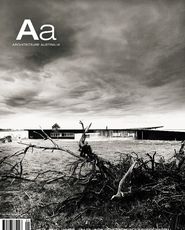PAUL MEMMOTT REFLECTS ON SHIFTS AND DEVELOPMENTS IN INDIGENOUS HOUSING OVER THE LAST FIFTEEN YEARS. WHAT HAS HAPPENED AND HOW MIGHT THE PROFESSION CONTRIBUTE MORE?
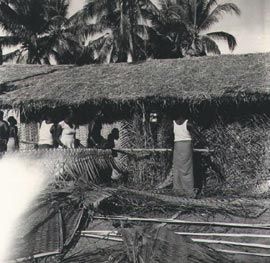
Bamboo and woven coconut-leaf house, Mer, Torres Strait, 1958. Photograph Jeremy Beckett.
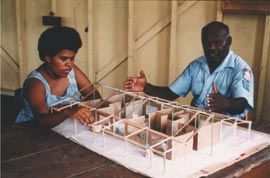
Hobson and Anna Levi with a cardboard model of their new home, Torres Strait, 1986. Photograph Paul Haar.
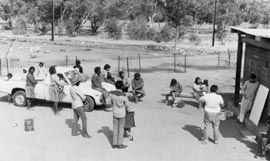
Housing management meeting of tenants in a Town Camp, Alice Springs, 1987. Photograph James Ricketson.
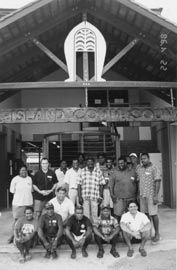
Participants in a community housing management workshop, Yam Island, Torres Strait, 1998. Photograph Paul Memmott.
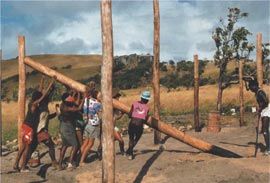
Self-help housing group, Moa Island, Torres Strait, c1987. Photograph Paul Haar.

A Warlpiri jilimi or women’s residence, Nyirripi, Northern Territory, 1994. Image Cathy Keys.
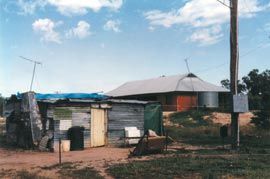
A humpy retained as a past lifestyle symbol in a rural town in western New South Wales in 1999 with an ATSIC house behind. Photograph Paul Memmott.
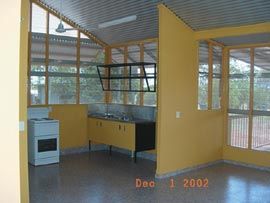
National Aboriginal Health Strategy project, kitchen at Galiwin’ku, Arnhem Land, 2002, by Troppo Architects. Photograph Richard Layton.
IN JUNE 1988, Architecture Australia published my paper “Aboriginal Housing: The state of the art (or non-state of the art)”.1 The title hints at the thrust of its argument, namely, how little was understood about the complex cross-cultural problem of Aboriginal housing, with the result that government policy seemed poorly informed and relatively ineffective in offsetting the backlog of housing in Aboriginal Australia. I concluded that paper with a prescription of what architects might do:
“Architects need to accelerate their research effort to document and evaluate their housing solutions, continue studies of domiciliary lifestyle, investigate aspects of the Aboriginal phenomenology of objects, link their research to models of cultural change, examine the potential application of findings at regional levels, educate younger practitioners (especially Aboriginal ones) and encourage them to participate in this specialised field.” ›› So what has happened in the intervening fifteen-year period (1988–2003)? One significant achievement has been the maturing of the design approach to Aboriginal housing by architects, as documented in the recently launched Take 2 Housing Design in Indigenous Australia (edited by myself and Catherine Chambers), the outcome of the RAIA’s 2002 Sisalation Prize.2 In this monograph I argue that the collection of specialist knowledge and skills related to the design of housing for Aboriginal Australians has emerged as an architectural sub-discipline. One of its chief components centres on how an understanding of the cultural differences inherent in Aboriginal domiciliary behaviour can inform the design process. This can be described as the cultural design paradigm.
Two other architectural paradigms have also impacted on Aboriginal housing design in recent years – the environmental health paradigm and the housing-as-process philosophy – both of which also contribute to the distinctiveness of this field of study and practice. Reconciling these three approaches within the design process has become a key challenge for contemporary practitioners. I shall briefly describe each of these paradigms in turn.
The cultural design paradigm involves the use of models of culturally distinct behaviour to inform definitions of Aboriginal housing needs. The culturally distinct behavioural use of domiciliary space involves typical diurnal/nocturnal behaviour patterns for different seasonal periods, distinct types of household groups, forms of approach and departure behaviour to domiciliary spaces, external orientation and sensory communication between domiciles, sleeping behaviour, cooking behaviour and use of hearths, characteristic uses of storage for artefacts and resources, and structured sociospatial behaviours. The premise of this paradigm is that to competently design appropriate residential accommodation for Aboriginal people who have traditionally oriented lifestyles, architects must understand the nature of those lifestyles, particularly in the domiciliary context. This knowledge also increases understanding of the needs of groups who have undergone cultural changes, including those in rural, urban and metropolitan settings, by helping to identify those aspects of their customary domiciliary behaviour that have been retained. The approach has been developed by a variety of practitioners and is analysed in Take 2. For example, the first essay by Julian and Barbara Wigley, who have thirty years of experience in the field, outlines a series of design conundrums in Aboriginal housing arising from particular cultural issues. (Also see the pieces by Cathy Keys and Shaneen Fantin.)
The most widespread of these design dilemmas is that although clients may well retain their culturally unique norms of behaviour when they move into their new conventional houses, many display a strong architectural conservatism which results in requests for conventional-looking houses. Any deviation from the local white standards of rural or urban housing may be resented. Behind such reaction often lies an understandable desire to achieve equality, to be accepted, to have some modest but recognized status and not to be ridiculed. The provision of anything but a conventional house may often be regarded as an insult. If the design is inappropriate this may result in stress and eventually damage, disillusionment and evacuation. One challenge then is how to design what appears to be a conservative house on the outside but which suits the culturally specific lifestyle typified by external orientation as well as other factors.
More needs to be done to educate Aboriginal people, especially in rural and remote areas, about the meaning of architectural design and the desirability of a “design-fit” between house and client’s lifestyle, as well as the occupancy adjustments and problems which tenants should expect to incur.
The attention given to architectural technology and detailing by a number of the Take 2 authors (including Jane Dillon, Mark Savage and Sue Groome) leads the reader into the second paradigm: environmental health design. This approach emerged from within Nganampa Health Council in Alice Springs, which services the Anangu Pitjantjatjara homelands in the north-west of South Australia. In 1986, Nganampa, in conjunction with the South Australian Government, sponsored a review of environmental and public health in these homelands. Architect Paul Pholeros combined his architectural skills with those of Paul Torzillo, a doctor, and Steph Rainow, an anthropologist, to develop an understanding of the critical relationships between poor Aboriginal health and housing technology performance. The resulting document has become known as the “UPK report”. Pholeros et al. have produced further books about their work, most recently under the logo of Healthabitat, as well as a series of important papers. Their work culminated in a commission from the Commonwealth, State and Territory Housing Ministers’ Working Group on Indigenous Housing to prepare The National Indigenous Housing Guide, and their methodology has been practically applied through a large-scale ATSIC project entitled “Fixing Houses for Better Health Project” (1000 houses) and the ongoing Department of Family and Community Services national “Fixing Houses for Better Health 2 and 3” programmes (1500 houses).3 Despite some contradictions between the design practice guidelines or methods advocated by the proponents of the cultural design paradigm and the environmental health paradigm, these two approaches can and should be complementary. Together they lead into a third architectural paradigm: the housing-as-process philosophy, which aims to firmly situate housing design and provision within the broader framework of an Aboriginal community’s planning goals and cultural practices, as well as its socioeconomic structure and development. One fundamental aspect of this approach involves design attention being given to a community’s housing management capacities to ensure that all technology is locally sustainable.
This subject is introduced in Take 2 in Simon Scally’s essay on outstation architecture in the Top End. A second grass-roots proponent of this philosophy is the architect and builder Paul Haar, who has extensive experience in self-help Indigenous housing projects. The housing-as-process philosophy is considered more systematically as a design methodology in the essay by Geoff Barker whose work stretches across remote Western Australia and the Northern Territory. Finally, the integration of social planning and architectural design in the context of a metropolitan setting that has been rife with drug abuse, violence and police conflict is examined in the paper on Redfern by Col James, Angela Pitts and Dillon Kombumerri. Their writings reflect a recent formula proposed for successfully sustainable Aboriginal housing by the ATSIC Commissioner Alison Anderson, who draws from international development experiences.4 This formula involves the following considerations: participation – ensuring the active participation of both men and women; consultation – supporting both the traditional owners and the residents who use and own the housing to make the key decisions concerning the housing; choice – helping to find technology which is appropriate to the community and not the donor; training – equipping and training communities to operate, maintain, and manage their new housing and infrastructure technologies; and demand driven – ensuring that projects match the true demand of the people who will use them.
Why was the Take 2 monograph prepared? While there have been eight other important books published on Aboriginal housing, they are either individual case studies of projects or settlements, or they deal with Indigenous housing from non-architectural perspectives. Despite the specialist nature of Aboriginal housing design, there has not been a book produced which deals with this subject from a broadly architectural perspective, encompassing general principles and contrasting paradigms, and offering examples from around the continent.
The RAIA’s recent successful launches of the monograph in Brisbane and Sydney resulted in vigorous dialogue amongst the contributing authors who noted that the RAIA had been relatively dormant concerning Indigenous issues since the early 1970s when it sponsored the Aboriginal Housing Panel. There was a unanimous agreement that the RAIA should take more initiatives with respect to Indigenous issues and that the Take 2 contributors might continue to network as a group in order to progress such proposals.
This returns me to the conclusion of my 1988 paper and I wish to raise five points that were made in that paper in order to reflect on what has, and has not, been achieved since then. First I wrote: “It is essential to educate and involve Aboriginal people in the provision of their housing, at least to the extent that they appreciate the process of design, delivery and maintenance of housing so that they can exercise control over key decisions in all of this process… Such decision-making has to be integrated with the provision of other social services and the solving of other social and economic problems such as breakdown in social cohesion and control, unemployment, alcoholism, impact of visitors on communities and internal conflicts.” ›› This prescription promotes the housing-as-process paradigm and calls for educational materials for communities, but the pertinent question that I wish to raise now is what progress has been made in training Indigenous architects? In 1988 there were no Indigenous graduates of architecture schools; in 2003 there are, I believe, about eight. It is clear that there is a need to increase Indigenous participation in architectural education and practice in Australia. What can the architecture schools and the RAIA do about this?
A second point I made in 1988 was that “Federal and state governments should reexamine their histories of providing housing to Aborigines and document their mistakes instead of constantly re-inventing the wheel and committing the same errors. They should set goals to establish an efficient and stable approach to the provision and preservation of housing stock before the end of this century.” ›› One government policy approach that runs counter to the cultural design paradigm and which has regularly recurred from state to state over the last thirty years is “mainstreaming” housing service delivery. This approach seems to be reinvented in cycles of political time and is currently happening in some states. Mainstreaming implies that a single unvaried service is provided to the general public. However, it may thereby inadvertently disadvantage a cultural group due to conflict with their customary values, practices and obligations, in which case it can legally be construed as constituting indirect discrimination. By contrast, the cultural design paradigm constitutes “targeted service delivery”. (Between these two extremes is “ethno-sensitive mainstreaming” whereby the mainstreaming approach is modified by some culturally specific techniques.) Housing administrators also need to recognize that housing management systems must also accommodate culturally specific behaviours. To not take cultural needs into consideration, both at the housing design and management levels, may ultimately result in a service failure. Such was the case of the “Tenant from Hell” (as she was reported in the media) who eventually challenged the Director of a State Housing Department in court in the late 1990s after the eviction of her family.5 Incongruencies between the service and the clients’ needs can also be detected using post-occupancy evaluation studies, but unfortunately governments seldom expend funds on such.
The third point I wish to return to is: “The RAIA needs to reactivate its ethical and political role in these matters as a responsible professional body. It took the initiative once in 1973. It is capable of doing it again in 1988.” This has not occurred. It would seem appropriate in the current era of reconciliation that the RAIA develop an ethical position in relation to Indigenous people and environmental issues. This should include recognition of traditional ownership, native title and Indigenous geographic and cultural heritage values, including in development projects; and, most important, recognition of the ongoing poor quality of built environments (including housing, correctional and other institutional environments) for Indigenous people and the constant backlog of unaddressed housing need.
This leads to the fourth point, that “The ‘Aboriginal housing problem’ has its own unique scale of dimensions that are not commensurate with the current short-term cycles of Australian political time.” A recent press release by ATSIC states there is a twenty-year backlog of Indigenous housing in Australia. Let us consider the case of the Northern Territory: the Indigenous Housing Authority, IHANT, spends $42 million per annum on its Indigenous population of about 60,000. The current shortfall to adequately house everybody in the Territory is calculated at $820 million, yet the current Indigenous population growth rate is three times the national average.6 To complete the calculations for the other states would no doubt see this figure soaring into the billions. This is not just a matter of a funding shortfall. There is also a shortage of suitably qualified architects in the field.
Finally, I wrote in my 1988 paper: “There is an unquestionable need for a central research and development agency along similar lines to the old panel with an Aboriginal steering committee but structured so as to have assured stability and autonomy in order that its continuity is not disrupted by political ebbs and tides…” Although the two Take 2 launches were generally regarded as very successful events, the lack of architectural practitioners in attendance was disappointing. To rectify this, it was thought that if a one-day conference stream was planned on Aboriginal architecture for the next (or following) national RAIA Conference, the quality of knowledge and debate generated at the Take 2 launches could potentially be shared with a much larger pool of practitioners. This would also give the opportunity for the Take 2 group to hold a closed practice workshop to develop an ongoing agenda in relation to the above and other related items. This could become a recurring event in order to maintain a focused national approach.
Reforms and initiatives such as those as outlined above would provide an appropriate and timely part of the agenda for the Year of the Built Environment in 2004 and I would urge the architectural profession and its Institute to give them due consideration, given the current widespread lack of sustainability and health in Indigenous built environments.
ASSOCIATE PROFESSOR PAUL MEMMOTT IS DIRECTOR OF THE ABORIGINAL ENVIRONMENTS RESEARCH CENTRE AT THE UNIVERSITY OF QUEENSLAND.

